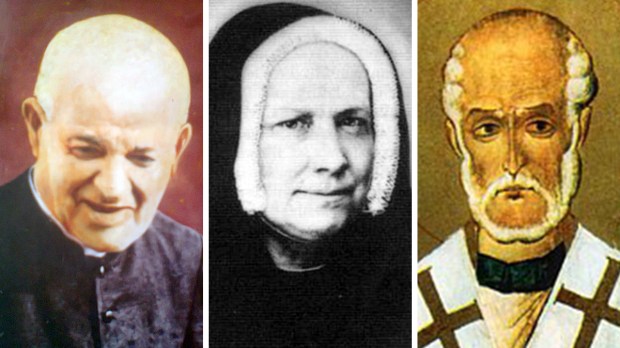In the wake of a hurricane, those affected find themselves surrounded by destruction, mourning those who have been lost and trying to rebuild. As we pray for the victims and the survivors of hurricanes, Saints who have suffered similarly can join us in praying. And in discerning how we can help—whether through giving time, expertise, or money—we can find inspiration in those Saints who also worked to rebuild amid devastation.
St. Gregory Thaumaturgus (213-270) was a scholar from Asia Minor who converted to Christianity as a teenager. He became bishop of Caesarea, where there were only 17 Christians; tradition has it that by the end of Gregory’s tenure, there were only 17 pagans, due to his preaching and to the many miracles he worked. These miracles earned him the moniker “Gregory the Wonder Worker.” But beyond the usual healings, Gregory’s prayers worked wonders on the natural world as well—the type of miracles urgently needed in hurricane-ravaged lands. He once dried up a lake to settle a land dispute. He ordered an enormous boulder to move and looked on while it obeyed. And on one occasion, Gregory prayed over a river that frequently flooded; after he planted his staff in the ground, it grew into a tree and the waters of that river never rose past the level of the tree again.
St. Frigidian of Lucca (d. 588) was an Irish priest who was called forth from his hermitage to be bishop of Lucca, Italy. Frigidian reformed the clergy, but he also spent time working with his hands. When the cathedral in Lucca was burned by the Lombards, Frigidian rebuilt it. And when locals asked his help with a river that kept overflowing its banks, Frigidian didn’t just pray against this systemic issue. Instead, he took a hoe, prayed over it, then dragged it through the dirt to dig a safer course fo the river, which changed its course to follow the one laid out for it by Frigidian.
St. Stephen Theodore Cuénot (1802-1861) was a French missionary bishop in Vietnam who was so successful that his one diocese soon had to be divided into four to provide for the needs of the thousands of converts Bishop Cuénot and his people had made. He was arrested for his faith and imprisoned, but due to the flooding in Central Vietnam that year, water rose in his cell, reaching to his waist. So prolonged was his partial submersion that Bishop Cuénot became seriously ill. This illness soon exhausted him and he died after only three weeks in prison.
St. Paula Frassinetti (1809-1882) was the Italian foundress of the Dorothean Sisters. A quiet and shy young woman, Paula was courageous when it came to souls, especially to mothering the Sisters in her order. One convent was located in a valley that had experienced serious flooding; to encourage the Sisters there, Mother Paula risked her life to go visit them. At one point on the journey, the wheels of her carriage were entirely submerged and the horse was terrified. The driver began to turn around, but Mother Paula insisted that they go on. A few moments later, a terrible noise caused them to turn around and see the road where they would have been washed away. Because of her commitment to those suffering from these floods, Mother Paula was saved—and the Sisters at her destination strengthened to persevere.
St. Rosa Fan Hui (1855-1900) was a single Chinese teacher who had been baptized as a baby and raised in a Catholic family. When the Boxer Rebellion broke out, Rosa returned to her home, hoping to avoid the persecution but preparing herself for death as well. She was betrayed to the Boxers and tortured, during which she prayed calmly. At one point, she interrupted the abuse, saying, “Wait till I finish my prayers, then you can kill me.” They respected this request, but when Rosa indicated that she was ready the Boxers attacked her, then threw her into the river to die by drowning.
St. George Preca (1880-1962) was a Maltese priest who survived a near drowning when he was a small child. Pulled out of the waters by a passing fisherman, Preca went on to become a priest and to work vigorously for the catechetical formation of Maltese laypeople. He established a system to train the laity so they could instruct others. At the time, it was considered suspect to give such power to the laity and Fr. George was ordered to close all the catechetical centers he had opened. Eager to be obedient, he did just that. The centers were re-opened the following year (with the bishop’s blessing) and Fr. George was recognized as a great gift to the Church of Malta, all because he had been saved from drowning so many years earlier.


